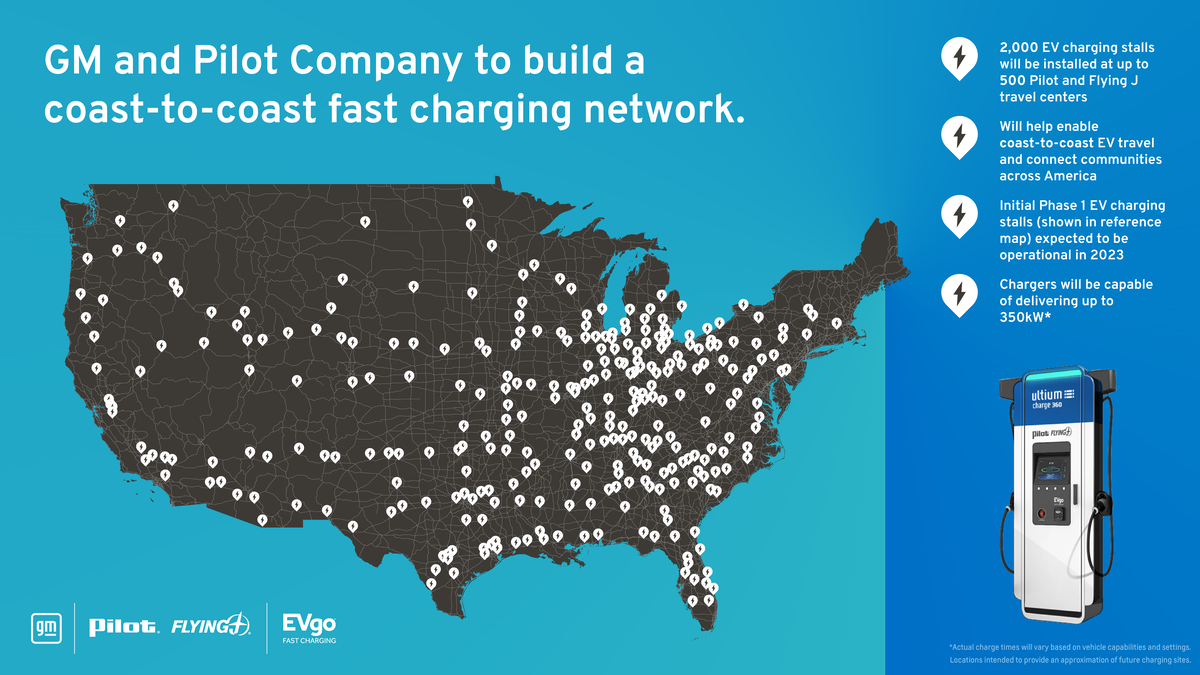Pilot Co. will install 2,000 electric fast chargers at 500 of its U.S. truck stops over the next few years, creating a coast-to-coast network in partnership with General Motors.
Startup EVgo (NASDAQ: EVGO) will install, operate and maintain the chargers. The chargers are branded as part of GM’s Ultium Charge 360 network. Chargers will begin appearing at U.S. Pilot and Flying J service plazas in early 2023. The majority of the 500 installations will be in place by 2025, Cathy Zoi, EVgo CEO, said on a conference call with news media Wednesday.
“There’s not one passenger car right now that can actually take the 350, but we’re anticipating what’s coming, Zoi said. “We’re putting in the 350s to anticipate these larger vehicles with larger batteries.”
150 miles of charge in 10 minutes
A 350kW charger could provide 150 miles of driving range in 10 minutes, said Travis Hester, GM chief EV officer.
“That’s going to be kind of the normal expectation that people are getting into,” he said. “We believe we should be creating a network that’s built for the future, which means it needs to center itself around 350-kilowatt chargers.”
Earlier, the automaker (NYSE:GM) committed nearly $750 million to:
• Enable access to more than 100,000 charge points in the U.S. and Canada through its Ultium Charge 360 ecosystem.
• Build out a network of 3,250 charging stalls in major metro areas by 2025 by collaborating with EVgo.
• Install up to 40,000 chargers in local dealer communities through GM’s Dealer Community Charging Program, focusing on underserved rural and urban areas.
The new direct-current (DC) chargers will serve passenger vehicles from all brands placed at roughly 50-mile intervals across the county.

GM vehicle owners get exclusive reservations, discounts on charging, a streamlined charging process through Plug and Charge and integration into GM’s vehicle brand apps that provide real-time charger availability and help with route planning.
DC chargers demand a lot of electricity. Pilot will charge customers for the juice. But it may sell it at a discount as part of incentive programs, said Shameek Konar, CEO of privately held Pilot.
Pilot Co., GM and EVgo are tapping federal infrastructure funds to help pay for the network.
No meaningful truck use — yet
The network doesn’t address heavy-duty trucks because so few are on the road. The few hundred Class 8 electric trucks in use cover drayage or local and regional routes that match their typical single-charging range of 150 to 200 miles.
“When you look at the trucking side of it, it is way behind where the automobile or four-wheeler customer is in terms of number of electric vehicles capable of doing long-distance hauling on electricity,” Konar said.
Hydrogen competes with battery-electric charging for long-haul freight because it is a drop-in fuel with fill-up times similar to diesel.
“We’re staying very close to all of the large fleets, and we’re happy to provide those services when the demand for it comes up,” Konar siad. “Some of those vehicles may be in commercial use. But if you’re talking about the big 18-wheelers, there just is not much of a market right now.”
Truck charging network joint venture planned
The issue for electric trucks is charging availability. The GM-Pilot network could help small commercial vehicles, like battery-electric delivery vans from GM’s BrightDrop subsidiary.
Daimler Truck North America, BlackRock Renewable Power and NextEra Energy Resources said in February they plan a $650 million joint venture to build charging infrastructure for electric and hydrogen fuel cell medium- and heavy-duty trucks.
The first phase of construction is expected to begin in 2023 on a network of charging sites on critical freight routes along the East and West coasts and in Texas by 2026. The plan is to leverage existing infrastructure and amenities while adding greenfield sites.
The Pilot-GM network has several advantages over other installations. Each Pilot site covers a lot of real estate, allowing charging installations to fit easily. Pilot’s relationships with utilities can overcome delays in permitting and construction.
Related articles:
Daimler Truck, BlackRock and NextEra Energy’s $650M bet on electric infrastructure
Electric truck charging: Can infrastructure keep pace with demand?

LanaWright
Stay at home mom Kelly Richards from New York after resigning from her full time job managed to average from $6000-$8000 a month from freelancing at home…
This is how she done it……. http://Www.JobsRevenue.com